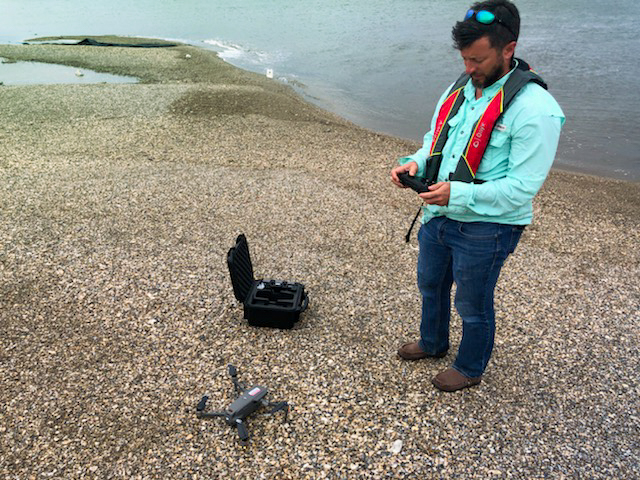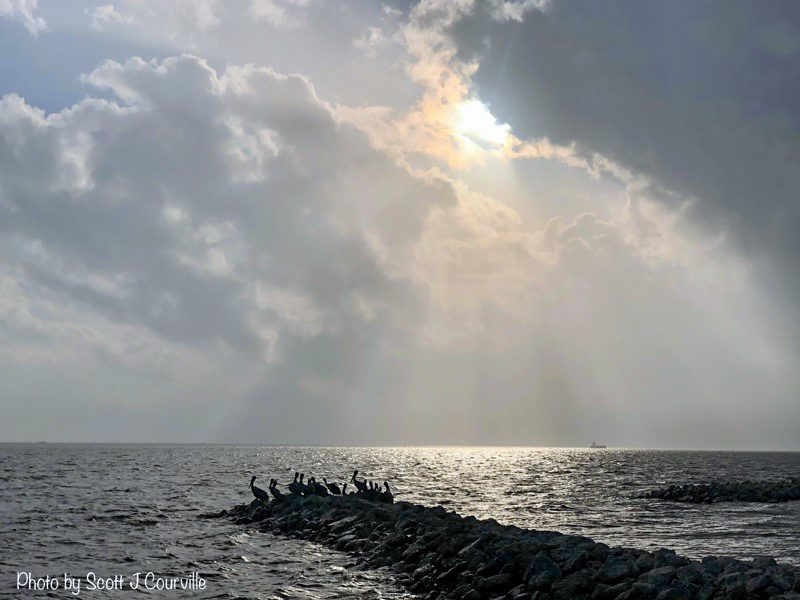 Menu
Menu
- Fenstermaker Insights
- Environmental
- Dreams Come True: Restoring the Louisiana Coast and Saving the Pelicans
Fenstermaker Insights
Dreams Come True: Restoring the Louisiana Coast and Saving the Pelicans
By Coy LeBlanc – March 9, 2020

Growing up, I had an interest in two things. The first was my passion for everything outdoors. As a kid, I loved being outside enjoying nature and exploring the woods, wondering how things worked. I asked myself, “Where did that tree come from?” and “I wonder which one of these fish I’m catching are related?” The second passion was technology. My dad was an IT professional. While working on computers at home, I would annoy him with questions like, “How are those colors projected onto that screen?”, or “How can that computer know what to do without you telling it?”

Fast forward several years. I remember sitting in a senior class wondering what I was going to do for the rest of my life. That day, a Biologist from Wildlife and Fisheries visited our class. He brought in live alligators and talked about restoring the coast. I remember thinking, “You know what, this is something I can see myself doing.” I want to save Louisiana’s coast. This day forever changed my career path. Shortly afterward, I enrolled at the University of Louisiana at Lafayette and earned my bachelor’s degree in Environmental and Sustainable Resources.
After graduating, I started what I thought was the best job ever. I was a team member for the Coastwide Reference Monitoring Systems (CRMS). There, I was able to see firsthand the deterioration of Louisiana’s coastline as we monitored hydrology, soils, and vegetation of the coast. Even though my dream of helping the Louisiana coast was not part of my role at the time, I knew the data we were collecting was beneficial to other biologists around the state who had the same hopes and dreams that I had. After seven years of collecting data, I knew I could have an impact in other ways. While being out in the coastal ecosystem was exciting, I was still missing the innovation and forward-thinking part of my childhood dreams.
I decided to change paths and was able to join the team at Fenstermaker, where the goals of restoring Louisiana’s coast were set pretty high. I was encouraged to further my knowledge and pursued a Master of Science from the University of Louisiana, where I worked on a research project combining my two-childhood interests. While working on this project, I fell in love with what I consider to be my life-long goal. I was able to combine the joys of being in the environment with my “techy side” as UAV’s were now being used for coastal restoration efforts.
While I was learning the hardware and software of this emerging tech, my mind was racing with ideas on how we could use these advanced systems to improve how we tackled the problems facing the Louisiana coast. While attending an ESRI conference in San Diego, the motto for the week was “See What Others Can’t.” This motto led me to my first large-scale project with our team here at Fenstermaker: the restoration of Queen Bess Island.
Let me give you a little background on the project. Queen Bess Island is a nesting habitat for the Louisiana Brown Pelican. Over the years, the island had subsided from 36 acres to only 5, thus threatening the future of our precious state bird. The island needed a redesign and a rebuild for protection of the Brown Pelican and many other bird species that make Queen Bess their home.
While the Queen Bess effort was becoming a popular and highly publicized project for the Coastal Restoration community, I was allowed to introduce technologies that had never before been implemented. Under the direction of supreme team leaders, expert engineers, and a team always willing to help each other, I was able to provide daily details of construction that had never been made available.
Our team flew pre-programmed daily flights, and I was able to process the field information immediately, to provide almost instant data to our team of engineers and our client. Delivery of field data to the client could be achieved within a matter of hours, a vast improvement from the previous standard of several weeks. With these aerials, we were able to look at current construction and resolve issues within a day instead of several weeks. Along with a physical picture to review progress, we are providing vegetation analysis and establishing a vegetation baseline for the entire island with revisits scheduled for ongoing monitoring. All of this is possible without stepping foot on the island.
As the final stages of the Queen Bess project are now in place, and the birds have returned to the island, we have visual documentation of the progress of the project and a baseline moving forward. The vision of our team and the support of our organization has allowed us to provide client-focused, technology-driven results to achieve what has not been possible before. We are encouraged to think outside of the box and let our passions drive us. Because of this mindset, my childhood dreams of making a difference in restoring the coast have become a reality. The success of the Queen Bess project and the role I was allowed to play has been the most significant accomplishments of my career. I am grateful for the culture here at Fenstermaker that offers constant support and allows all of us the opportunity to dream big.

Your company’s success is our business
Discover our industry-leading products and service that our customers have been trusting in for decades. Whatever your need, we’re here.